The Impact of Physical Motion Cues on Driver Braking Performance: A Clinical Study Using Driving Simulator and Eye Tracker
Abstract
:1. Introduction
2. Materials and Methods
2.1. Participants
2.2. Instruments
2.2.1. Simulator and Motion Platform
2.2.2. Eye Tracker
2.2.3. Questionnaire
2.3. Data Analysis
2.4. Experimental Design
2.5. Experiment Procedure
3. Experimental Results
3.1. Simulator Data
3.2. Eye Tracker Data
3.2.1. “Without Signs” Scenario
3.2.2. “With Signs” Scenario
3.3. Questionnaire Data
4. Discussion
5. Conclusions
Author Contributions
Funding
Institutional Review Board Statement
Informed Consent Statement
Data Availability Statement
Conflicts of Interest
References
- Bruck, L.; Haycock, B.; Emadi, A. A Review of Driving Simulation Technology and Applications. IEEE Open J. Veh. Technol. 2021, 2, 1–16. [Google Scholar] [CrossRef]
- Wynne, R.A.; Beanland, V.; Salmon, P.M. Systematic review of driving simulator validation studies. Saf. Sci. 2019, 117, 138–151. [Google Scholar] [CrossRef]
- Chen, J.; Wang, X.; Cheng, Z.; Gao, Y.; Tremont, P.J. Evaluation of the optimal quantity of in-vehicle information icons using a fuzzy synthetic evaluation model in a driving simulator. Accid. Anal. Prev. 2022, 176, 106813. [Google Scholar] [CrossRef]
- Yeo, D.; Kim, G.; Kim, S. Toward Immersive Self-Driving Simulations: Reports from a User Study across Six Platforms. In Proceedings of the CHI’20: 2020 CHI Conference on Human Factors in Computing Systems, Honolulu, HI, USA, 25–30 April 2020; pp. 1–12. [Google Scholar] [CrossRef]
- Hock, P.; Kraus, J.; Babel, F.; Walch, M.; Rukzio, E.; Baumann, M. How to design valid simulator studies for investigating user experience in automated driving—Review and hands-on considerations. In Proceedings of the 10th International Conference on Automotive User Interfaces and Interactive Vehicular Applications, AutomotiveUI 2018, Toronto, ON, Canada, 23–25 September 2018; pp. 105–117. [Google Scholar] [CrossRef]
- Fares, A.; Wickens, C.M.; Mann, R.E.; Di Ciano, P.; Wright, M.; Matheson, J.; Hasan, O.S.M.; Rehm, J.; George, T.P.; Samokhvalov, A.V.; et al. Combined effect of alcohol and cannabis on simulated driving. Psychopharmacology 2022, 239, 1263–1277. [Google Scholar] [CrossRef]
- Goode, N.; Salmon, P.M.; Lenné, M.G. Simulation-based driver and vehicle crew training: Applications, efficacy and future directions. Appl. Ergon. 2013, 44, 435–444. [Google Scholar] [CrossRef] [PubMed]
- Naweed, A. Simulator integration in the rail industry: The Robocop problem. Proc. Inst. Mech. Eng. Part F J. Rail Rapid Transit 2013, 227, 407–418. [Google Scholar] [CrossRef]
- Nikitenko, A.; Shvets, A. Software and hardware simulators for train drivers training: Overview of possibilities and effects of application. Prz. Elektrotechniczny 2020, 96, 198–201. [Google Scholar] [CrossRef]
- Allen, R.W.; Park, G.D.; Cook, M.L. Simulator fidelity and validity in a transfer-of-training context. Transp. Res. Rec. 2010, 2185, 40–47. [Google Scholar] [CrossRef]
- Rosenbloom, T.; Eldror, E. Effectiveness evaluation of simulative workshops for newly licensed drivers. Accid. Anal. Prev. 2014, 63, 30–36. [Google Scholar] [CrossRef]
- Freeman, P.; Neyens, D.M.; Wagner, J.; Switzer, F.; Alexander, K.; Pidgeon, P. A video based run-off-road training program with practice and evaluation in a simulator. Accid. Anal. Prev. 2015, 82, 1–9. [Google Scholar] [CrossRef]
- Meuleners, L.; Fraser, M. A validation study of driving errors using a driving simulator. Transp. Res. Part F Traffic. Psychol. Behav. 2015, 29, 14–21. [Google Scholar] [CrossRef]
- Cleij, D.; Venrooij, J.; Pretto, P.; Katliar, M.; Bülthoff, H.; Steffen, D.; Hoffmeyer, F.; Schöner, H.-P. Comparison between filter- and optimization-based motion cueing algorithms for driving simulation. Transp. Res. Part F Traffic. Psychol. Behav. 2019, 61, 53–68. [Google Scholar] [CrossRef]
- Koyuncu, A.B.; Ercelik, E.; Comulada-Simpson, E.; Venrooij, J.; Kaboli, M.; Knoll, A. A Novel Approach to Neural Network-based Motion Cueing Algorithm for a Driving Simulator. In Proceedings of the IEEE Intelligent Vehicles, Las Vegas, NV, USA, 19 October–13 November 2020; pp. 2118–2125. [Google Scholar] [CrossRef]
- Asadi, H.; Bellmann, T.; Mohamed, S.; Lim, C.P.; Khosravi, A.; Nahavandi, S. Adaptive Motion Cueing Algorithm using Optimized Fuzzy Control System for Motion Simulators. IEEE Trans. Intell. Veh. 2022, 8858, 1–13. [Google Scholar] [CrossRef]
- Khusro, Y.R.; Zheng, Y.; Grottoli, M.; Shyrokau, B. MPC-Based Motion-Cueing Algorithm for a 6-DOF Driving Simulator with Actuator Constraints. Vehicles 2020, 2, 625–647. [Google Scholar] [CrossRef]
- Asadi, H.; Lim, C.P.; Mohamed, S.; Nahavandi, D.; Nahavandi, S. Increasing motion fidelity in driving simulators using a fuzzy-based washout filter. IEEE Trans. Intell. Veh. 2019, 4, 298–308. [Google Scholar] [CrossRef]
- Asadi, H.; Lim, C.P.; Mohammadi, A.; Mohamed, S.; Nahavandi, S.; Shanmugam, L. A genetic algorithm–based nonlinear scaling method for optimal motion cueing algorithm in driving simulator. Proc. Inst. Mech. Eng. Part I J. Syst. Control Eng. 2018, 232, 1025–1038. [Google Scholar] [CrossRef]
- Mohellebi, H.; Espié, S.; Kheddar, A.; Arioui, H.; Amouri, A. Design of Low-Clearance Motion Platform for Driving Simulators. In Mechatronics Safety, Secur Dependability a New Era; Elsevier: Amsterdam, The Netherlands, 2007; pp. 401–404. [Google Scholar] [CrossRef]
- Arioui, H.; Hima, S.; Nehaoua, L.; Bertin, R.J.V.; Espié, S. From design to experiments of a 2-DOF vehicle driving simulator. IEEE Trans. Veh. Technol. 2011, 60, 357–368. [Google Scholar] [CrossRef] [Green Version]
- Khadeir, A.M.; Saehood, Z.A.; Mutar, H.S.; Abduljabbar, A.S.; Al-Dahwi, A.M.; Abdulameer, R.H.; Mohammed, A.A. Building and validation of a low-cost driving simulator. In Journal of Physics: Conference Series; IOP Publishing: Bristol, UK, 2021; p. 1973. [Google Scholar] [CrossRef]
- De Frutos, S.H.; Castro, M. Assessing sim racing software for low-cost driving simulator to road geometric research. Transp. Res. Procedia 2021, 58, 575–582. [Google Scholar] [CrossRef]
- Llopis-Castelló, D.; Camacho-Torregrosa, F.J.; Marín-Morales, J.; Pérez-Zuriaga, A.M.; García, A.; Dols, J.F. Validation of a low-cost driving simulator based on continuous speed profiles. Transp. Res. Rec. 2016, 2602, 104–114. [Google Scholar] [CrossRef] [Green Version]
- Huang, A.R.W.; Chen, C. A low-cost driving simulator for full vehicle dynamics simulation. IEEE Trans. Veh. Technol. 2003, 52, 162–172. [Google Scholar] [CrossRef]
- Mecheri, S.; Lobjois, R. Steering Control in a Low-Cost Driving Simulator: A Case for the Role of Virtual Vehicle Cab. Hum. Factors 2018, 60, 719–734. [Google Scholar] [CrossRef] [PubMed]
- Mclane, R.C.; Wierwille, W.W. The Influence of Motion and Audio Cues on Driver Performance in an Automobile Simulator. Hum. Factors 1975, 17, 488–501. [Google Scholar] [CrossRef] [Green Version]
- Siegler, I.; Reymond, G.; Kemeny, A.; Berthoz, A. Sensorimotor Integration in a Driving Simulator: Contributions of Motion Cueing in Elementary Driving Tasks. DSC Europe 2001, 21–32. Available online: https://citeseerx.ist.psu.edu/document?repid=rep1&type=pdf&doi=66a310c99462f7652afb9ba3beb94c9b369771db (accessed on 16 December 2022).
- Colombet, F.; Dagdelen, M.; Kemeny, A. Motion Cueing: What’s the Impact on the Driver’s Behaviour? In Proceedings of the Driving Simulation Conference; 2008; pp. 171–181. Available online: https://www.researchgate.net/profile/Frederic-Merienne/publication/237305826_Motion_Cueing_what%27s_the_impact_on_the_driver%27s_behaviour/links/0deec52ebc25740a16000000/Motion-Cueing-whats-the-impact-on-the-drivers-behaviour.pdf (accessed on 16 December 2022).
- Denjean, S.; Roussarie, V.; Kronland-Martinet, R.; Velay, J.L. How does interior car noise alter driver’s perception of motion? Multisensory integration in speed perception. In Proceedings of the Acoustic 2012 Nantes Conference, Nantes, France, 23–27 April 2012. [Google Scholar]
- Reinhard, R.T.; Kleer, M.; Dreßler, K. The impact of individual simulator experiences on usability and driving behavior in a moving base driving simulator. Transp. Res. Part F Traffic. Psychol. Behav. 2019, 61, 131–140. [Google Scholar] [CrossRef]
- Pathirana, P.; Senarath, S.; Meedeniya, D.; Jayarathna, S. Eye gaze estimation: A survey on deep learning-based approaches. Expert Syst. Appl. 2022, 199, 116894. [Google Scholar] [CrossRef]
- Tanoubi, I.; Tourangeau, M.; Sodoké, K.; Perron, R.; Drolet, P.; Bélanger, M.; Morris, J.; Ranger, C.; Paradis, M.-R.; Robitaille, A.; et al. Comparing the visual perception according to the performance using the eye-tracking technology in high-fidelity simulation settings. Behav. Sci. 2021, 11, 31. [Google Scholar] [CrossRef] [PubMed]
- Ojsteršek, T.C.; Topolšek, D. Eye tracking use in researching driver distraction: A scientometric and qualitative literature review approach. J. Eye Mov. Res. 2019, 12, 1–30. [Google Scholar] [CrossRef] [PubMed]
- Carr, D.B.; Grover, P. The role of eye tracking technology in assessing older driver safety. Geriatrics 2020, 5, 36. [Google Scholar] [CrossRef]
- Khan, M.Q.; Lee, S. Gaze and eye tracking: Techniques and applications in ADAS. Sensors 2019, 19, 5540. [Google Scholar] [CrossRef] [Green Version]
- Ledezma, A.; Zamora, V.; Sipele, Ó.; Sesmero, M.; Sanchis, A. Implementing a gaze tracking algorithm for improving advanced driver assistance systems. Electronics 2021, 10, 1480. [Google Scholar] [CrossRef]
- Gomolka, Z.; Kordos, D.; Zeslawska, E. The application of flexible areas of interest to pilot mobile eye tracking. Sensors 2020, 20, 986. [Google Scholar] [CrossRef] [Green Version]
- Le, A.S.; Suzuki, T.; Aoki, H. Evaluating driver cognitive distraction by eye tracking: From simulator to driving. Transp. Res. Interdiscip. Perspect. 2020, 4, 100087. [Google Scholar] [CrossRef]
- Boer, E.R. A Multi-Sensory Cybernetic Driver Model of Stopping Behavior: Comparing Reality Against Simulators with Different Cue-Rendering Fidelities. IFAC-PapersOnLine 2016, 49, 349–354. [Google Scholar] [CrossRef]
- Bouchner, P.; Novotny, S. Development of advanced driving simulator: Steering wheel and brake pedal feedback. In Proceedings of the 2nd International Conference on Circuits, Systems, Control, Signals, CSCS’11, Prague, Czech Republic, 26–28 September 2011; pp. 170–174. [Google Scholar]
- Bouchner, P.; Novotný, S. Car dynamics model—Design for interactive driving simulation use. In Proceedings of the 2nd International Conference on Applied Informatics and Computing Theory, AICT’11, Prague, Czech Republic, 26–28 September 2011; pp. 285–289. [Google Scholar]
- Pragolet. Your Real Simulator; Pragolet s.r.o.: Mnichovice, Czech Republic, 2022; Available online: http://www.pragolet.cz (accessed on 16 December 2022).
- Wei, M.Y.; Chen, S.W. Optimal Control-based Motion Cueing Algorithm Design for 6DOF Motion Platform. In Proceedings of the 4th International Conference on Knowledge Innovation and Invention 2021, ICKII 2021, Taichung, Taiwan, 23–25 July 2021; pp. 216–222. [Google Scholar] [CrossRef]
- Tobii Pro Glasses 3. 2022. Available online: https://www.tobii.com/products/eye-trackers/wearables/tobii-pro-glasses-3 (accessed on 16 December 2022).
- Olsen, A. The Tobii I-VT Fixation Filter: Algorithm description. Tobii. Technol. 2012, 21, 4–19. [Google Scholar]
- Reuten, A.J.C.; Bos, J.E.; Smeets, J.B.J. The metrics for measuring motion sickness. Actes (IFSTTAR) 2020, 1, 183–186. [Google Scholar]
- Fitzpatrick, K.A.Y.; Mason, J.M. Review of AASHTO Green Book Procedures for Sight Distance at Ramp Terminals Vehicle Acceleration from a Stopped Position. Transp. Res. Rec. 1984, 1280, 190–198. [Google Scholar]
- Sahami, S.; Sayed, T. How drivers adapt to drive in driving simulator, and what is the impact of practice scenario on the research? Transp. Res. Part F Traffic. Psychol. Behav. 2013, 16, 41–52. [Google Scholar] [CrossRef]
- Ronen, A.; Yair, N. The adaptation period to a driving simulator. Transp. Res. Part F Traffic. Psychol. Behav. 2013, 18, 94–106. [Google Scholar] [CrossRef]
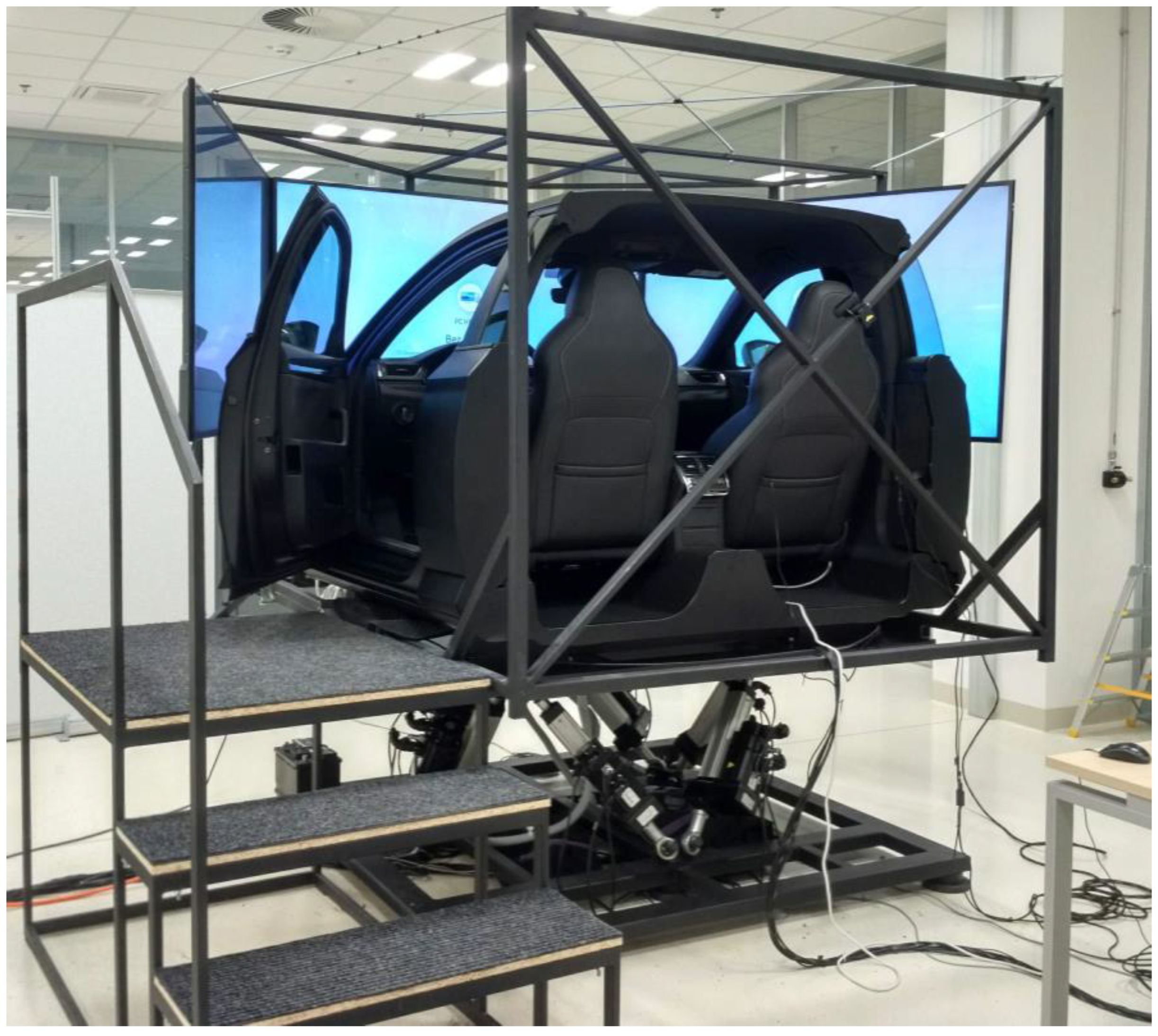
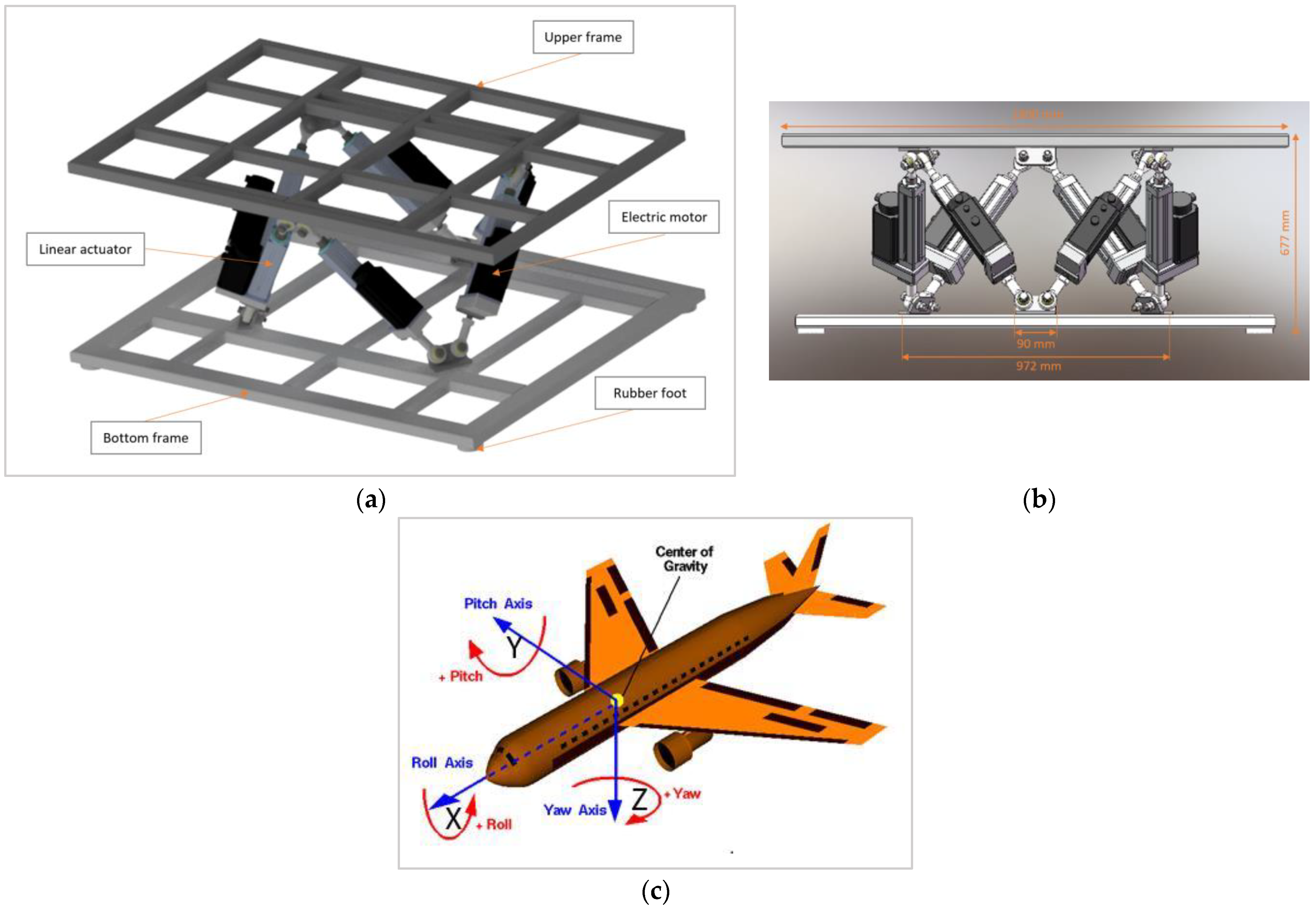


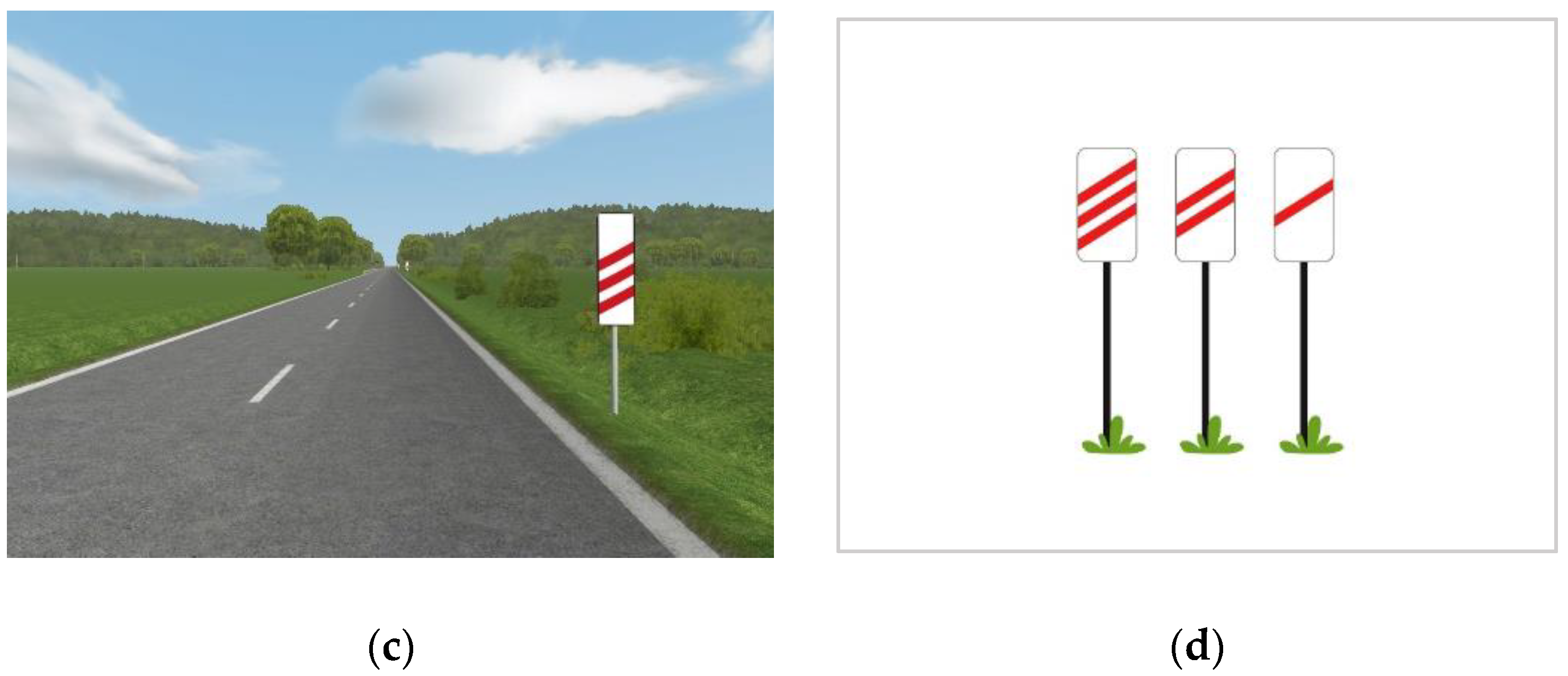

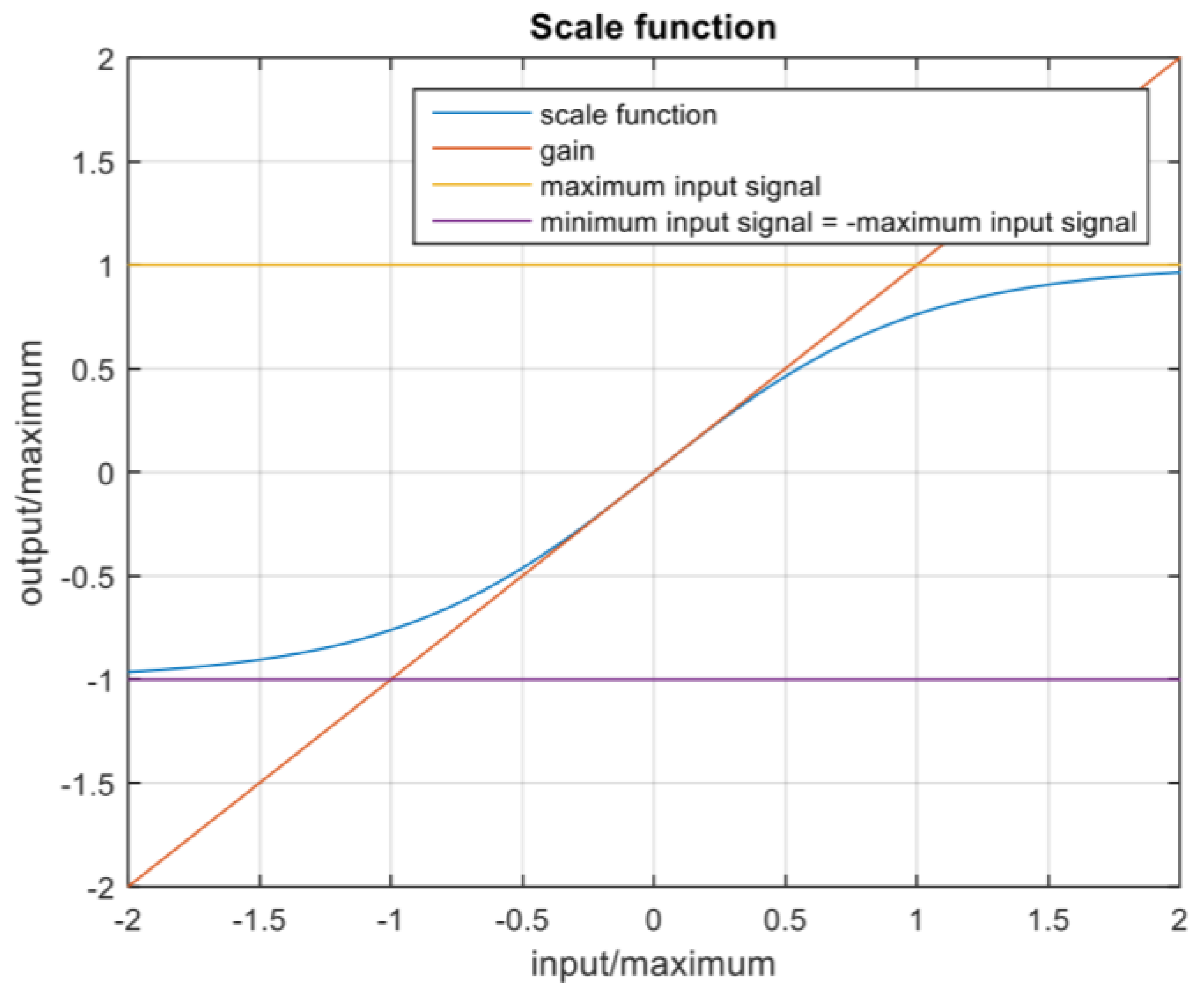
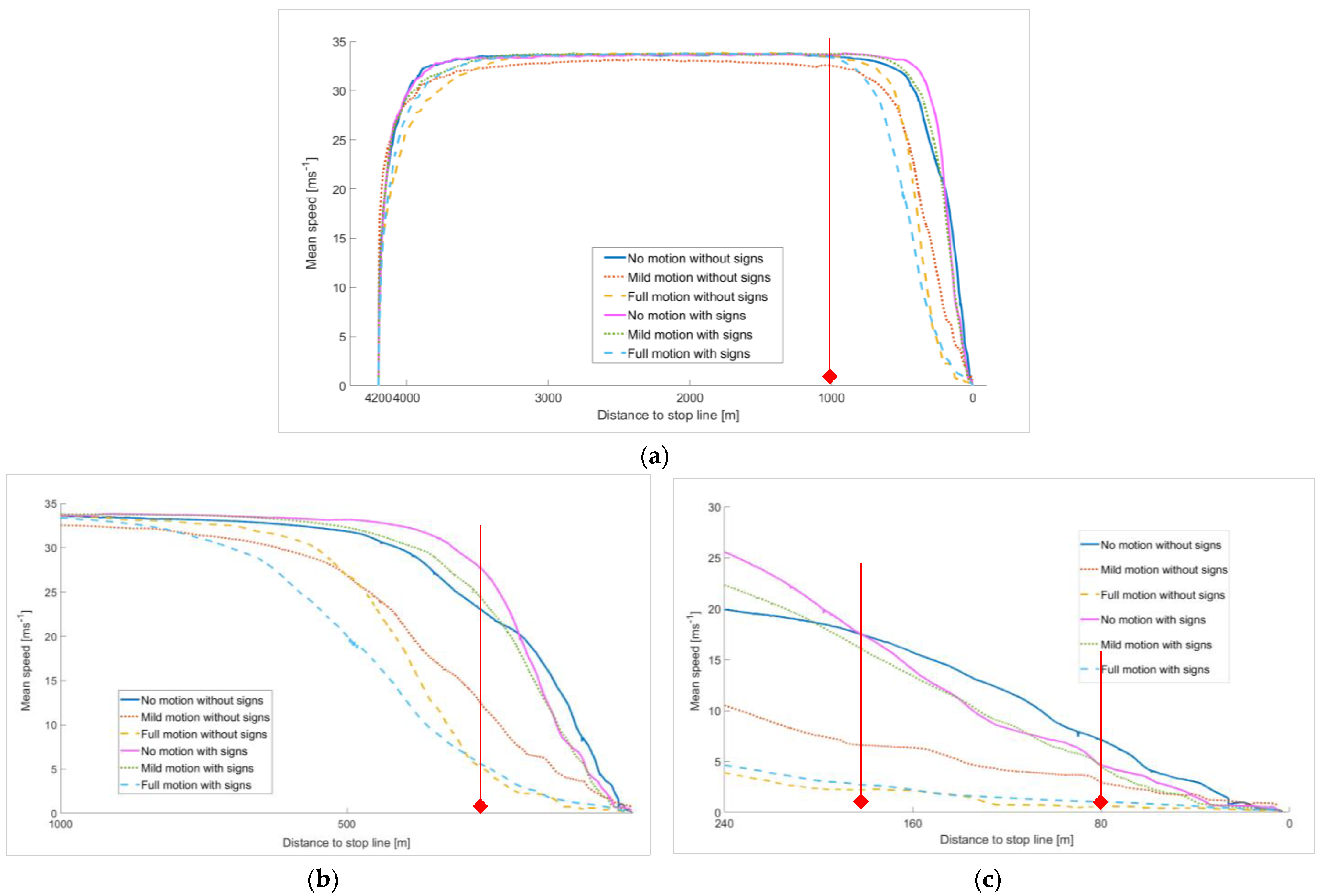
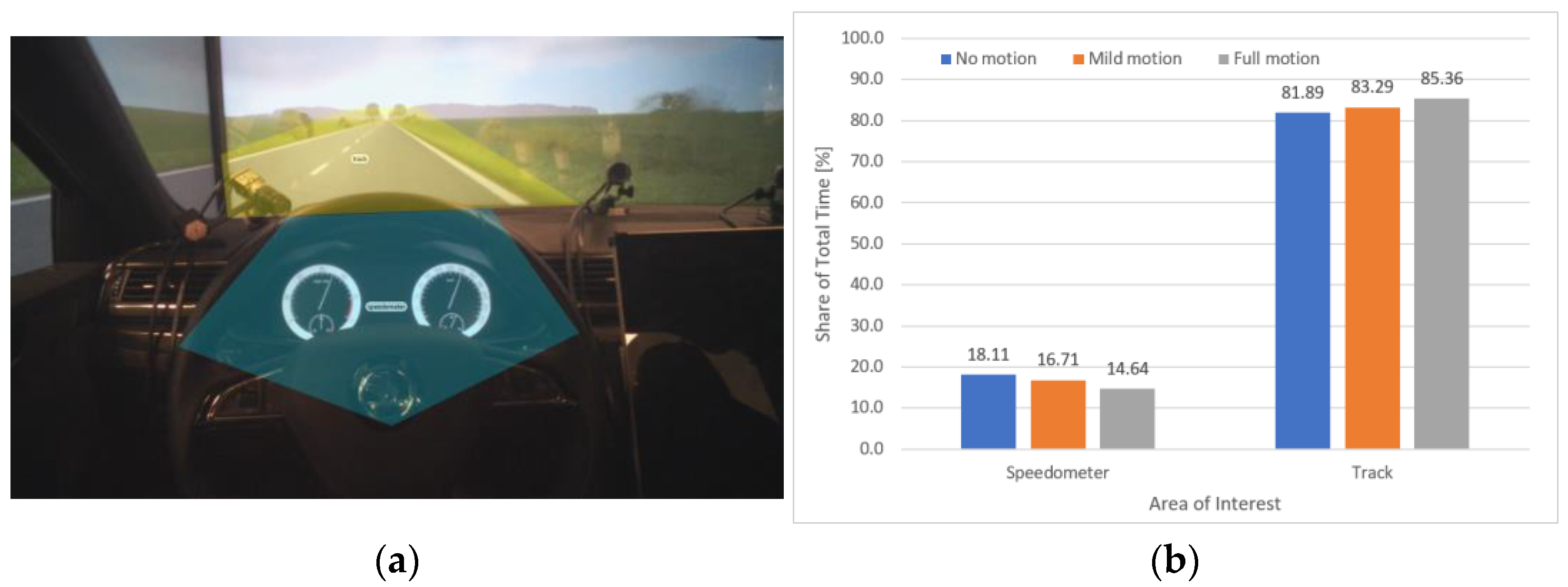


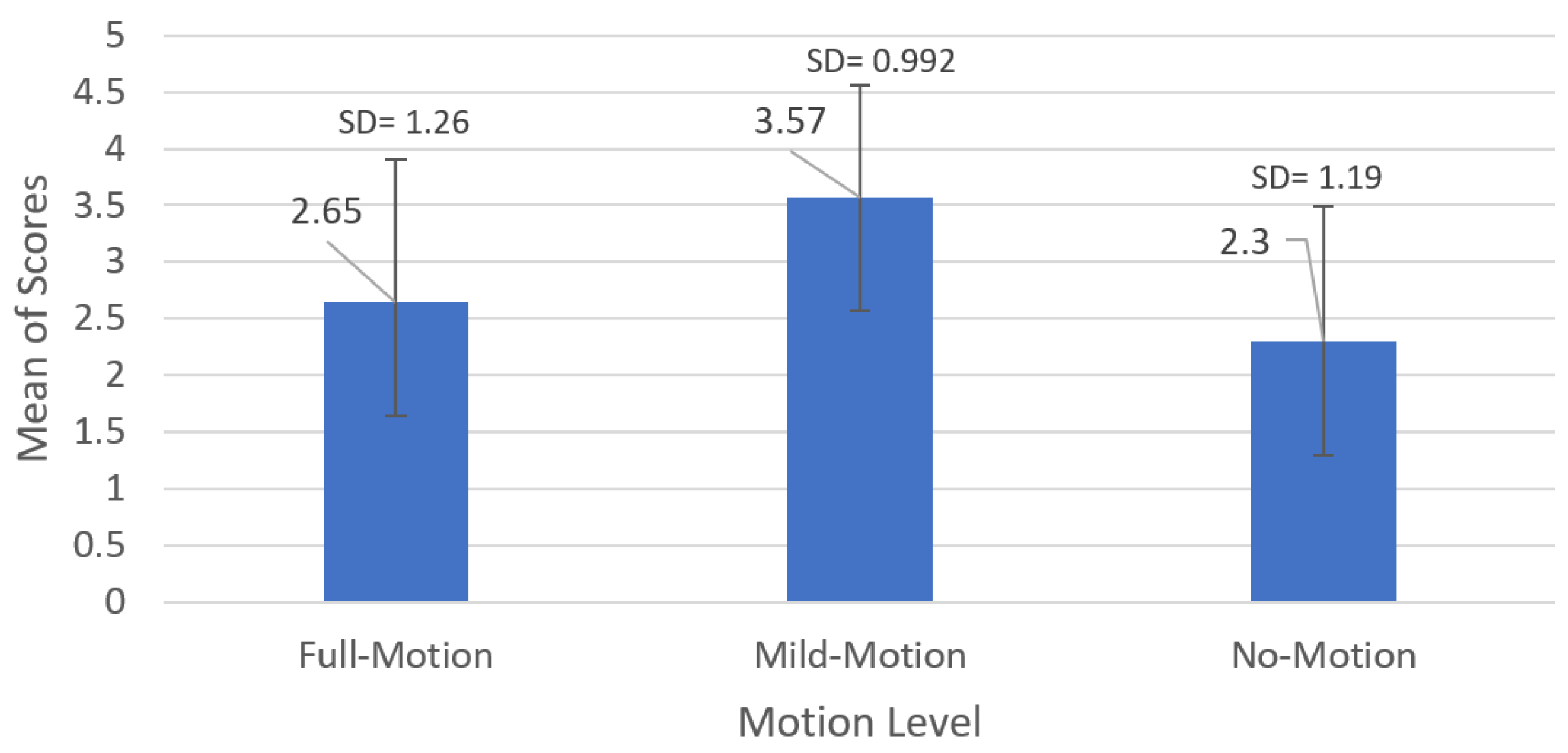
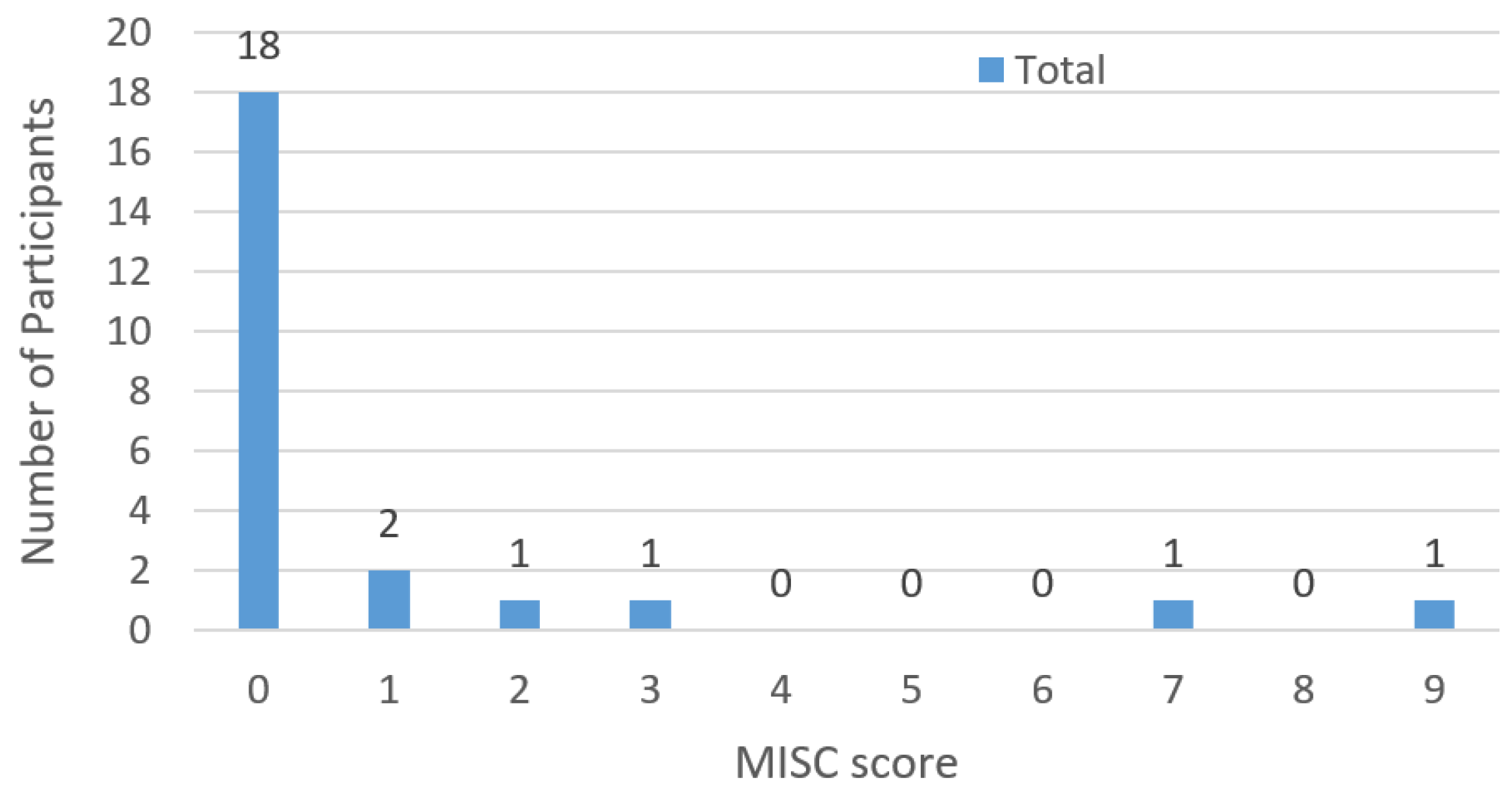
| Symptom | Score | |
|---|---|---|
| No problems | 0 | |
| Uneasiness (no typical symptoms) | 1 | |
| Dizziness, warmth, headache, stomach awareness, sweating … | vague | 2 |
| slight | 3 | |
| fairly | 4 | |
| severe | 5 | |
| Nausea | slight | 6 |
| fairly | 7 | |
| severe | 8 | |
| retching | 9 | |
| Vomiting | 10 |
| Motion Parameter | Description | Axis | Motion Level | ||
|---|---|---|---|---|---|
| No Motion | Mild Motion | High Motion | |||
| Maximum Acceleration [rad/s2] | Limit for input linear acceleration, which defines the Scale function. | xAcc | 0 | 0.7 | 1.5 |
| yAcc | 0 | 0.55 | 1.1 | ||
| zAcc | 0 | 0.7 | 1.5 | ||
| Maximum Angular Velocity [rad/s] | Limit for input angular velocity, which defines the Scale function. | xAV | 0 | 0.07 | 0.15 |
| yAV | 0 | 0.07 | 0.15 | ||
| Gain [-] | Multiplication factor (gain) of the linear acceleration that defines the Scale function. | xG | - | 0.45 | 0.9 |
| yG | - | 0.1 | 0.2 | ||
| zG | - | 0.15 | 0.3 | ||
| Df | Sum Sq | Mean Sq | F | p-Value 1 | |
|---|---|---|---|---|---|
| Motion Level Score | 2 | 19.51 | 9.754 | 7.337 | 0.00133 |
| Residuals | 66 | 87.74 | 1.329 |
Disclaimer/Publisher’s Note: The statements, opinions and data contained in all publications are solely those of the individual author(s) and contributor(s) and not of MDPI and/or the editor(s). MDPI and/or the editor(s) disclaim responsibility for any injury to people or property resulting from any ideas, methods, instructions or products referred to in the content. |
© 2022 by the authors. Licensee MDPI, Basel, Switzerland. This article is an open access article distributed under the terms and conditions of the Creative Commons Attribution (CC BY) license (https://creativecommons.org/licenses/by/4.0/).
Share and Cite
El Hamdani, S.; Bouchner, P.; Kunclova, T.; Lehet, D. The Impact of Physical Motion Cues on Driver Braking Performance: A Clinical Study Using Driving Simulator and Eye Tracker. Sensors 2023, 23, 42. https://doi.org/10.3390/s23010042
El Hamdani S, Bouchner P, Kunclova T, Lehet D. The Impact of Physical Motion Cues on Driver Braking Performance: A Clinical Study Using Driving Simulator and Eye Tracker. Sensors. 2023; 23(1):42. https://doi.org/10.3390/s23010042
Chicago/Turabian StyleEl Hamdani, Sara, Petr Bouchner, Tereza Kunclova, and David Lehet. 2023. "The Impact of Physical Motion Cues on Driver Braking Performance: A Clinical Study Using Driving Simulator and Eye Tracker" Sensors 23, no. 1: 42. https://doi.org/10.3390/s23010042






